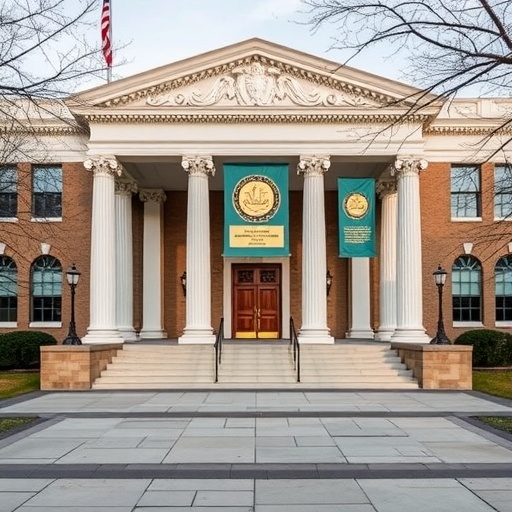Elite Universities Including MIT Reject Trump Administration’s Federal Funding Pact: Higher Education Stands Firm
In a bold stand against political influence in academia, seven prestigious Universities, including the Massachusetts Institute of Technology (MIT), have publicly rejected the Trump administration’s controversial offer for boosted federal funding tied to alignment with its policy priorities. The decision, announced just days after the October 20 deadline, has left the White House scrambling to secure commitments from other institutions, highlighting deep tensions between the federal government and higher education leaders over autonomy and research independence.
The compact, unveiled earlier this year by the Department of Education, promised Universities an additional 20% in federal funding—potentially billions of dollars—for research grants, student aid, and infrastructure projects. In return, participating schools would pledge to incorporate administration-favored curricula on topics like national security, economic nationalism, and climate skepticism into their programs. Critics, including the rejecting universities, decried it as an unprecedented intrusion into academic freedom, echoing historical battles over government oversight in higher education.
MIT’s rejection letter, signed by President L. Rafael Reif, emphasized the institution’s commitment to unbiased scientific inquiry. “We cannot compromise the integrity of our research and teaching for short-term financial gains,” Reif stated in the document obtained by this outlet. Similar sentiments were echoed by Brown University, Dartmouth College, the University of Southern California (USC), and others, including Yale, Princeton, and the University of Chicago. These seven universities represent a significant portion of the nation’s top-tier research powerhouses, collectively receiving over $5 billion in federal funding annually, according to National Science Foundation data.
This development comes at a critical juncture for higher education, where federal funding accounts for roughly 10-15% of university budgets nationwide, per the American Council on Education. The Trump administration’s push, part of a broader “America First” agenda in education reform, aimed to redirect resources toward programs aligning with its goals, such as vocational training in manufacturing and skepticism toward certain international collaborations. However, the rejections signal a potential roadblock, forcing officials to pivot and court less prominent schools while facing backlash from academic circles.
Seven Powerhouses Draw a Line in the Sand
The coalition of rejecting universities forms a formidable bloc in American higher education, each with storied legacies of innovation and independence. MIT, renowned for its cutting-edge work in engineering and artificial intelligence, leads the pack with its unequivocal no. The Cambridge-based institution, which boasts 97 Nobel laureates among its alumni and faculty, argued that the compact’s requirements could stifle groundbreaking research on global challenges like renewable energy and pandemic preparedness—areas where federal grants have been pivotal.
Brown University in Providence, Rhode Island, followed suit, with Provost Francis J. Doyle III releasing a statement underscoring the Ivy League school’s dedication to open discourse. “Higher education thrives on diverse perspectives, not mandated alignments,” Doyle said during a virtual press briefing. Dartmouth College, another Ivy member in Hanover, New Hampshire, highlighted its rural setting and focus on undergraduate teaching, warning that the deal could undermine its unique liberal arts mission. USC in Los Angeles, a private research powerhouse with strong ties to the entertainment and tech industries, cited potential conflicts with its diverse student body of over 47,000, including significant international enrollment.
Completing the list are Yale University, Princeton University, and the University of Chicago—icons of liberal arts and social sciences. Together, these institutions rejected an estimated $1.2 billion in potential additional funding, based on their current federal allocations. A joint open letter from their presidents, published in The Chronicle of Higher Education, framed the decision as a defense of the First Amendment principles embedded in academic life. “Universities are not political instruments; they are engines of truth-seeking,” the letter read, garnering over 10,000 signatures from faculty nationwide within 24 hours.
This unified front is no accident. Sources close to the negotiations reveal that informal discussions among university leaders began in August, facilitated by the Association of American Universities (AAU), which represents 62 leading public and private research institutions. The AAU’s executive director, Barbara Snyder, confirmed in an interview that the group advised against participation, citing risks to peer-reviewed research integrity. Statistics from the past decade show that federal funding has driven 60% of U.S. basic research, making the stakes extraordinarily high for universities reliant on grants from agencies like the National Institutes of Health (NIH) and the National Science Foundation (NSF).
Unpacking the Trump Administration’s Ambitious Funding Blueprint
The federal funding compact emerged from a series of executive orders issued by the Trump administration in early 2020, aimed at reshaping higher education to better serve national interests. Dubbed the “Patriot Education Initiative,” it proposed a $50 billion pot over five years, with allocations based on a school’s willingness to integrate priorities such as emphasizing American history from a “traditionalist” viewpoint, expanding STEM programs focused on defense technologies, and reducing emphasis on what the administration termed “divisive” topics like critical race theory.
Under the plan, universities would submit annual compliance reports, audited by the Department of Education, to unlock the extra funds. Proponents, including Education Secretary Betsy DeVos, argued it would counteract what they saw as left-leaning biases in academia. In a White House briefing on October 15, DeVos touted the initiative as a “win-win,” projecting that participating schools could see per-student funding rise by 15%, helping offset tuition hikes averaging 3.5% annually, per College Board data.
However, the fine print raised red flags. The compact included clauses allowing the administration to withhold funds for non-compliance, potentially affecting Title IV student aid programs that distribute $120 billion yearly. For MIT alone, which receives about $800 million in federal research dollars, the trade-off was untenable. Internal memos leaked to Politico revealed university concerns over censorship in grant proposals, particularly for climate science, where administration priorities clashed with consensus-driven findings from bodies like the Intergovernmental Panel on Climate Change (IPCC).
Broader context reveals the administration’s strategy as part of a larger pivot. Federal funding for higher education has grown 25% since 2016, adjusted for inflation, but disputes over strings attached—such as immigration policies impacting international students—have simmered. The October 20 deadline was set to coincide with midterm budget planning, pressuring universities amid post-pandemic financial strains, where enrollment dipped 2.5% and operating deficits hit $10 billion across the sector, according to Deloitte’s higher education report.
Voices from the Frontlines: Academia Clashes with Washington
The rejections have ignited a firestorm of reactions, with university administrators, faculty, and even students weighing in on the implications for higher education’s future. At a panel hosted by the American Association of University Professors (AAUP) on October 22, MIT’s Reif elaborated on the decision, drawing parallels to Cold War-era pressures on science. “We’ve seen governments try to steer research before, and it rarely ends well for innovation,” he noted, referencing the McCarthy-era blacklists that drove scientists abroad.
From the administration’s side, frustration is palpable. White House Press Secretary Kayleigh McEnany addressed the snubs during a daily briefing, calling the universities “elitist holdouts” disconnected from working Americans. “This funding could transform vocational programs in underserved communities, but ivory tower arrogance stands in the way,” she asserted. Insiders report that senior advisors are now targeting mid-tier state universities in red states, like Texas A&M and the University of Florida, which may be more amenable due to political alignments.
Student voices add emotional depth to the narrative. At USC, sophomore engineering major Maria Gonzalez, who relies on federal Pell Grants, expressed mixed feelings in a campus op-ed. “I support standing up for free speech, but what if this means fewer scholarships? Higher education should be accessible, not a political battlefield.” A survey by Inside Higher Ed found 68% of students at rejecting universities back the decision, valuing academic integrity over immediate financial perks.
Experts in education policy provide further insight. Dr. Elena Ramirez, a professor at Harvard’s Graduate School of Education, analyzed the fallout in a New York Times op-ed: “This isn’t just about money; it’s a referendum on whether federal funding can come with ideological handcuffs. Universities are signaling that higher education’s role in democracy outweighs any compact.” Ramirez cited a 2019 GAO report showing that politicized funding has already led to a 12% drop in international collaborations, harming U.S. competitiveness in fields like AI and biotech.
Lawmakers are also chiming in. Senate Minority Leader Chuck Schumer (D-NY) praised the universities on Twitter, vowing to introduce legislation protecting academic autonomy. Conversely, House Majority Leader Kevin McCarthy (R-CA) defended the initiative, arguing it addresses “woke indoctrination” in universities, a claim disputed by a 2021 Pew Research study finding no widespread ideological bias in faculty hiring.
Ripples Through Federal Funding Streams for Universities
The immediate fallout from these rejections extends far beyond the seven institutions, threatening the stability of federal funding pipelines that sustain American higher education. With the deadline passed, the Trump administration faces a shortfall in its enrollment goals; only a handful of smaller colleges, like Liberty University and Hillsdale College—known for conservative leanings—signed on, committing to less than 5% of the targeted $50 billion pool.
For universities like MIT, the decision means navigating tighter budgets without the promised boost. The institution’s 2020-2021 financial report shows federal grants comprising 45% of its research budget, funding projects from quantum computing to COVID-19 vaccines. Provost Martin A. Schmidt outlined contingency plans in an internal email, including increased private donations—MIT’s endowment stands at $27.4 billion—and partnerships with industry giants like Google and Boeing.
Nationwide, the ripple effects could exacerbate inequalities. Public universities, which educate 75% of U.S. students per the State Higher Education Executive Officers Association, may feel indirect pressure. If the administration redirects funds to compliant schools, non-participants could see a 5-10% cut in NSF allocations, impacting undergraduate research opportunities. A 2022 Brookings Institution analysis warns that such shifts could widen the urban-rural divide in higher education access.
Moreover, the controversy spotlights ongoing debates over federal funding’s role. Historically, the Morrill Act of 1862 established land-grant universities with federal support for practical education, evolving into today’s $150 billion ecosystem. Recent administrations, from Obama to Trump, have layered on conditions—Obamacare’s accountability measures, for instance—but the current compact’s explicit ideological bent marks a departure, per legal scholars at the ACLU.
International ramifications loom large. Foreign governments and philanthropists may view the U.S. as less reliable for collaborative research, especially after visa restrictions under Trump reduced international student numbers by 7%, according to the Institute of International Education. For higher education, this could mean lost tuition revenue—$45 billion annually—and diminished global talent pools.
Charting the Path Ahead: Administration’s Next Moves and Academia’s Resolve
As the dust settles, the Trump administration is intensifying outreach to alternative partners, with reports of overtures to community colleges and for-profit institutions like the University of Phoenix. A Department of Education spokesperson confirmed plans for a revised compact by December, potentially lowering compliance thresholds to attract broader participation. “We’re committed to investing in education that builds America, not divides it,” the statement read, hinting at incentives like tax breaks for donor-aligned programs.
For the rejecting universities, the focus shifts to advocacy and diversification. The AAU is lobbying Congress for a bipartisan bill to codify academic independence, building on the 1963 Higher Education Facilities Act. MIT and peers are also exploring state-level funding boosts; California, home to USC, recently allocated $500 million extra for public higher education amid similar tensions.
Looking further, this standoff could reshape federal-university relations for years. If Democrats regain congressional control in upcoming elections, expect probes into the compact’s legality, potentially leading to Supreme Court challenges on free speech grounds. Optimists in higher education point to resilience: despite past cuts, U.S. universities lead global rankings, with MIT topping QS World University Rankings for a decade.
Ultimately, the rejections underscore a core tension—federal funding’s vital role versus the peril of politicization. As one Yale dean put it in a faculty meeting, “We’ve chosen principle over purse strings, betting on the long-term health of higher education.” The coming months will test whether this gamble pays off, as universities brace for budget cycles and the administration hunts for willing allies in an increasingly polarized landscape.








